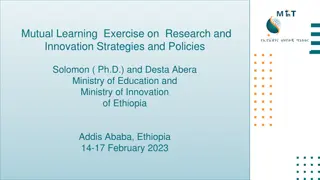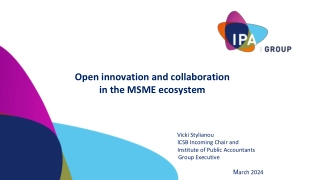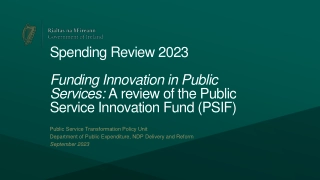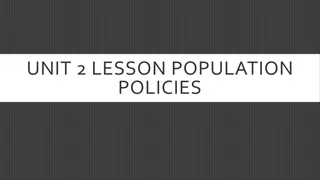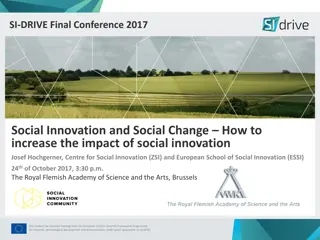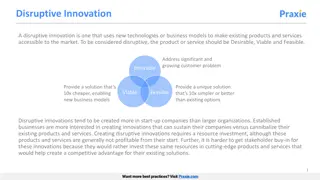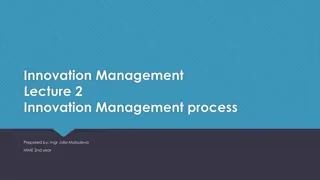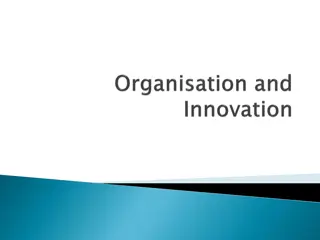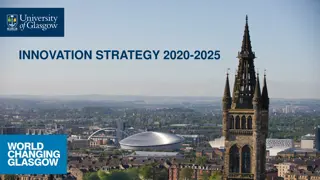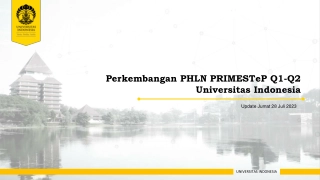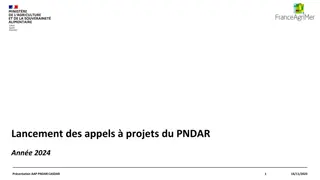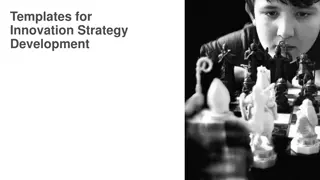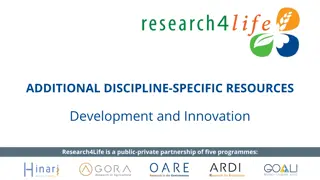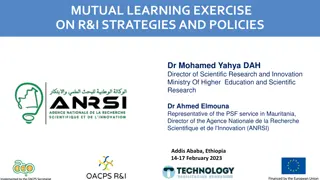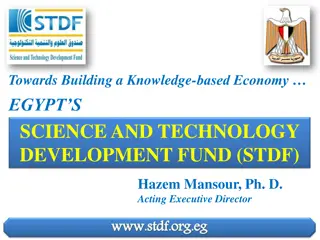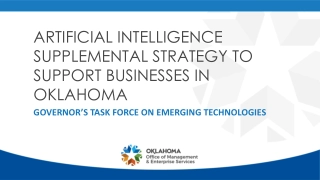Understanding the Potential of AI in Development and Innovation Policies
Artificial Intelligence (AI) has the potential to revolutionize economies by reducing production costs and enhancing efficiency. This technology is already playing a crucial role in various sectors globally. To harness the benefits of AI responsibly, it is essential to develop effective policies and regulatory frameworks. Innovation in AI requires a deep understanding of its impacts, promoting responsible usage to ensure sustainable growth.
Download Presentation

Please find below an Image/Link to download the presentation.
The content on the website is provided AS IS for your information and personal use only. It may not be sold, licensed, or shared on other websites without obtaining consent from the author. Download presentation by click this link. If you encounter any issues during the download, it is possible that the publisher has removed the file from their server.
E N D
Presentation Transcript
Bitrina Diyamett Science, Technology and Innovation Policy Research Organization (STIPRO) 18th August, 2021 Villgro Boot camp training on AI4D, 2021
Outline of the Presentation Introduction what is AI AI Potential in development Innovation and policies for AI Brief revisit to innovation process Innovation policies for promoting AI Policies for regulating the adverse impacts of AI Some concluding remarks 18th August, 2021 Villgro Boot camp training on AI4D, 2021
What is AI Artificial intelligence (AI) is artificial creation of human-like intelligence that can learn, reason, plan, perceive or process natural language through computer programs. Unlike the normal computer programs that are run through human intelligence, AI program gives the computer instructions that allow it to learn from data without new step-by-step instructions by the programmer (Internet Society, 2017. This way computers can be used for new, complicated tasks that could not be manually programmed Villgro Boot camp training on AI4D, 2021 18th August, 2021
AIPotential in development Economically, AI has enormous potential to bring down cost of production, enhance efficiency and thereby promotes growth of countries. According to a recent study on the long-term economic impact of AI around the world, it is stipulated AI to have the potential to double a country s GDP growth rate by 2035 (Access Partnership, ND). It is also estimated that by 2030,AI will add $15.7 trillion to the global GDP (Travally and Muyunyi, 2020). AI can/is also used in beneficial non economic activities, including efficient governance and provision of service, security and surveillance, etc. 18th August, 2021 Villgro Boot camp training on AI4D, 2021
AIPotential in development cont.. The use of AI is already a common place in rich countries, e.g. : more than half of the European manufacturers (51%) are implementing AI solutions, Japan,30% and the US, 28% (Capgemini s research institute (2020). Africa has shown some potential, but it is very much behind just like in many other new technologies. For this reasons concerted efforts are required to promote responsible AI in Africa. Good policies and regulatory frameworks are at the heart of this efforts. 18th August, 2021 Villgro Boot camp training on AI4D, 2021
Innovation and policies for AI Innovation process Being a new technology, policies for AI are generally those for innovation with additional regulatory frameworks because of potential for adverse impacts. Like all other policies, innovation policies requires a good understanding of the phenomenon and conditions that promotes it. Simply defined in economic terms - innovation is defined as market introduction of new or improved products and processes. Terminological distinctions between invention and innovation 18th August, 2021 Villgro Boot camp training on AI4D, 2021
Innovation process cont.. Factors facilitating innovation: An entrepreneur is at the center of the innovation process, but cannot innovate alone he/she requires host of other actors in the process, because: Innovation is systemic in nature, depending on three elements: Actors in the system (innovators and their suppliers, competitors and users, academia, governments, and financial institutions). Interactive learning among the system actors Policies and regulations. Will briefly discuss ii) and iii) i. ii. iii. 18th August, 2021 Villgro Boot camp training on AI4D, 2021
Innovation process cont.. Factors facilitating innovation cont.. Within the innovation system, there are two major interactive forces that are extremely important for putting a new technology on the market or useful use: -A scientific or technological possibility and demanding customers. -From the original linear model of innovation Do not just be excited by a scientific or technological possibility without an assurance of demand (current or future)- this tendency seems to be obvious with AI in Africa Villgro Boot camp training on AI4D, 2021 18th August, 2021
Innovation process cont.. Factors facilitating innovation cont.. Similarly, continuous close contact with the academia is extremely important As a radically new innovation diffuses in a social and economic system, new challenges and problems arise, which might require going back to the drawing board as far as basic scientific principles are concerned. Resolution of these problems is usually not in the capability of an entrepreneur, but scientific organizations such as universities and research institutions. Which is a major challenge of AI in Africa as very few universities teach and do cutting edge research on AI 18th August, 2021 Villgro Boot camp training on AI4D, 2021
Innovation Policies for AI Policies that promote AI: Generally, a public policy is a cause of action taken by the government to address a certain problem in society and achieve rational outcomes. Specifically innovation policy is understood as government actions aimed at strengthening innovation ecosystems i.e. influencing decisions by firms, consumers, academia and other agents to develop, disseminate and adopt scientific knowledge and innovate at the lowest cost and with the broadest impact in terms of performance and social and economic benefits (Alcanter, 2012) 18th August, 2021 Villgro Boot camp training on AI4D, 2021
Innovation policies to promote AI cont.. As a third element in the innovation system, policies do two major things: i) Build the capabilities of the system actors. -For instance for the AI, scientific capabilities is very limited in Africa very few universities teach and do high quality research in AI -Building capabilities also include provision of infrastructure. ICT infrastructure is also a policy challenge for AI in Africa. ii) Foster the interactive learning among the systems actors, e.g. strengthening the linkage between AI entrepreneurs and firms with universities and research organizations. Use demand side innovation policies, such as the public procurement to create effective demand for socially useful AI. 18th August, 2021 Villgro Boot camp training on AI4D, 2021
Innovation policies to promote AI cont.. Innovation policies are implemented through three major categories of instruments i) Financial incentives instruments There are wide range of financial instruments that are normally used to facilitate innovation in different social economic contexts, including: Innovation grants to SMEs and start-ups support to technology transfer (for instance through support to joint R&D between firms and universities/R&D organizations. support to venture and seed capital for the commercialization of new technologies. 18th August, 2021 Villgro Boot camp training on AI4D, 2021
Innovation policies to promote AI cont.. ii) Regulatory instruments These can be several generally the IPR system; one example is when patent and university laws are changed in order to allow public universities to own patents and to create the necessary organizational arrangements to stimulate the commercialization of knowledge, such as creation of incubators and spin-off companies. Some are more indirect: e.g. an environmental regulation forbids a specific polluting chemical substance; this induces product innovations or process innovations, because the regulation forces firms to find alternative solutions. 18th August, 2021 Villgro Boot camp training on AI4D, 2021
Innovation policies to promote AI cont.. iii) Soft policy instruments. These are voluntary and non-coercive. They are not subjected to obligatory measures, sanctions or direct incentives or disincentives by the government. Examples are: Dissemination of information about voluntary technical standards at the national and international levels . Dissemination of information on the importance of public private partnerships. Campaigns and public communication instruments (for example, diffusion of scientific knowledge by using events like research days or TV documentaries) 18th August, 2021 Villgro Boot camp training on AI4D, 2021
Policies for regulating the adverse impacts of AI If put into useful use and trained well, using good data, AI is good for social and economic development. But AI may be misused or behave in an unpredicted and potentially harmful ways, which makes governance and regulation of AI absolutely necessary. Some of the misuse of AI include: Deep fakes, which is creation of artificial videos, voice recordings, and data that could be used to fake dangerous events and issues that can destabilize harmony within societies. 18th August, 2021 Villgro Boot camp training on AI4D, 2021
Policies for regulating the adverse impacts of AI cont.. An example of how things can unexpectedly go wrong with the use of AI is Microsoft s chatbot, Tay, which was released on Twitter in 2016. due to the information it was receiving and learning from other Twitter users, the robot begun to post inflammatory and offensive tweets. Which forced Microsoft shut the chatbot down immediately . If you read, there are many examples of an AI program misbehaving or deepfakes 18th August, 2021 Villgro Boot camp training on AI4D, 2021
Policies for regulating the adverse impacts of AI cont.. Because of such challenges with AI, countries world over are trying to control the use of AI For deepfakes systematic ways on how to detect deepfakes just like other fake news - are being developed In regard to control the unexpected outcome of the otherwise good intention of the use of AI, countries are putting in place various regulatory frameworks. Cath, 2018) developed three sets of ideas on how to systematically develop and support the ethical, legal and technical governance of AI; these are: Ethical governance; Explainability and interpretability; and Ethical auditing 18th August, 2021 Villgro Boot camp training on AI4D, 2021
Policies for regulating the adverse impacts of AI cont.. Ethical governance includes: focusing on the most pertinent ethical issues raised by AI, covering issues such as fairness, transparency and privacy . Explainability and interpretability to increase algorithmic fairness, transparency and accountability e.g. entitles an individuals a right to obtain an explanation on what algorithm decides about them (e.g. refusal of loan application) Ethical auditing Auditing mechanisms are proposed as possible solutions that examine the inputs and outputs of algorithms for biases and harms 18th August, 2021 Villgro Boot camp training on AI4D, 2021
Concluding remarks AI is at the heart of development, and it is already a common place in rich countries, but very little is happening in Africa countries. Being a double edged technology, AI requires two sets of policies those that promotes growth and those that regulate its use. Implementation of these policies requires joint efforts of the private sector, academia, governments and the civil society Governments to enact and oversee implementation of policies Private sector to mind quality and ethics in their use of AI Academia to carry out more research Civil society to close the gaps left by the government and private sector 18th August, 2021 Villgro Boot camp training on AI4D, 2021
Thank you very much for your kind attention For more information on STIPRO please visit www.stipro.or.tz 18th August, 2021 Villgro Boot camp training on AI4D, 2021






